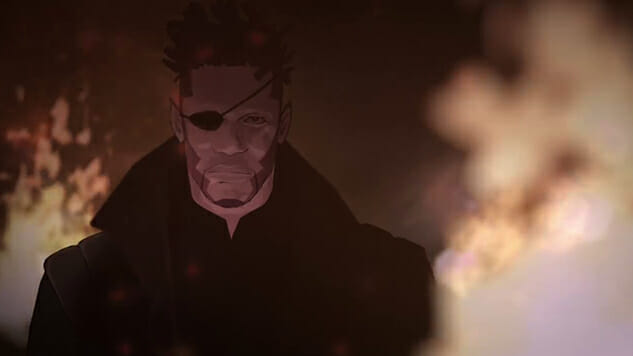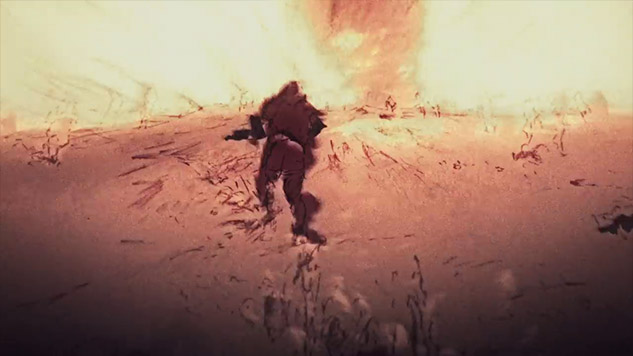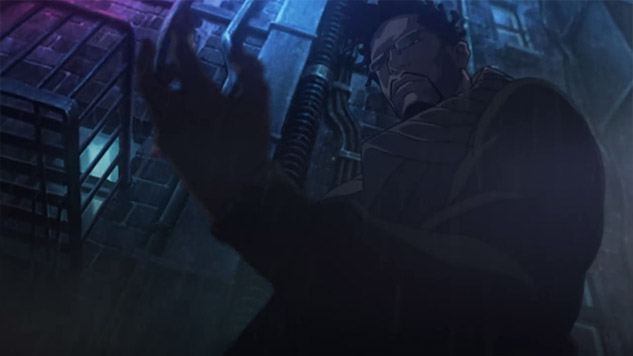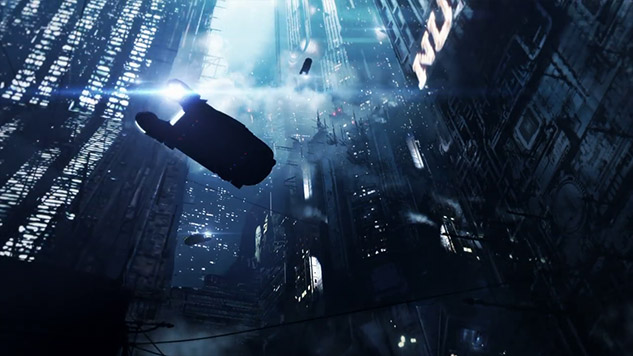
Last month, Blade Runner 2049 was released in theaters—30 years removed from Ridley Scott’s 1982 sci-fi noir and received with nigh-unanimous critical praise only dampened by muted commercial returns.
Blade Runner 2049’s existence alone is testament to the enduring appeal and perpetual timeliness of Scott’s original: the urtext of cyberpunk’s visual vocabulary. Animation, in particular Japanese animation, owes no small debt to the precedent of Blade Runner. The appeal of films like Katsuhiro Otomo’s Akira and Mamoru Oshii’s Ghost in the Shell would have likely resonated with global audiences regardless, though it would be hard to argue that Scott’s film didn’t prime audiences for cyberpunk’s collective vision of sprawling metropolises looming over derelict post-industrial landscapes.
As part of the promotional push for Blade Runner 2049, Warner Bros. and Alcon Media commissioned a series of short films of several major events leading up to the film’s release. While the first two shorts, directed by Luke Scott, are intriguing in their own right, Blade Runner 2022: Blackout, the third and final short, warrants the most attention.
Clocking in at just shy of 13 minutes, Blackout is perhaps one of the most exciting pieces of animation released this year, owed in no small part to a murderer’s row of some of the biggest talents working in Japanese anime today and an appropriately eerie score composed by none other than Flying Lotus.
Listed in order of their credits, here are the stories behind the animators of Blade Runner 2022: Blackout, as well as where you can find more of their work:
Shinichiro Watanabe (Director, Screenwriter)
Known for: Cowboy Bebop (1998), Samurai Champloo (2004), Space Dandy (2014)

Undoubtedly one of today’s most prolific anime directors, the very mention of Shinichiro Watanabe’s attachment to Blackout alone should be cause for celebration. Watanabe is a visionary auteur par excellence, his body of work bursting at the seams with cinematically charged premises, densely layered characters, impeccably curated multi-genre scores and idiosyncratic flair for the ineffably cool. His directorial sensibilities shine through the most in the human-replicant riots of Blackout’s opening scenes, animated by Shinji Hashimoto, a key animator for Katsuhiro Otomo’s Akira who worked with Watanabe previously on Samurai Champloo and The Animatrix shorts Kid’s Story and A Detective Story.
Shuko Murase (Key Animator, Character Designer, Animation Director)
Known for: Witch Hunter Robin (2002), Ergo Proxy (2004), Gangsta. (2015)

Second-billed behind Watanabe in Blade Runner 2022’s credits, Shuko Murase is distinctly responsible for the short’s elegant, sophisticated aesthetic as its principal character designer and animation director. Given his penchant for cleanly rendered character profiles, contemporary gothic fashion and terse, erudite storylines, Murase’s talents are a perfect fit for translating Blade Runner’s iconic neo-noir stylings to the medium of animation. For more Murase, check out the supernatural detective-action series Witch Hunter Robin, the dystopian cyberpunk drama Ergo Proxy and his latest feature-length adaptation of the late Project Itoh novel Genocidal Organ.
Hiroyuki Okiura (Key Animator)
Known for: Ghost in the Shell (1995), Jin-Roh (2001), A Letter to Momo (2011)

Commonly recognized for past collaborations with Mamoru Oshii as a animation supervisor/layout artist on the 1995’s Ghost in the Shell, and for his directorial debut on 2001’s Jin-Roh: The Wolf Brigade, Okiura is an animator renowned for the expressive realism of his sequences. His character’s bodies behave with uncanny corporeal heft, expressing a sense of gravity and motion seldom conveyed in most animation, signature qualities most apparent in Blackout’s climactic scene in which Iggy and Trixie mount an attack on the Tyrell Corporation’s database center of registered replicants. When Trixie throws the torn rear-view mirror of the fuel truck like a discus, then somersaults over the guard tower, the sequence demonstrates the type of extraordinary animation you can only expect from someone of Okiura’s caliber and vision.
Shinya Ohira (Key Animator)
Known for: Akira (1989), “The Origin of O-Ren” from Kill Bill Vol. 1 (2003), The Animatrix (2004), Mind Game (2004), Ping Pong (2014)

You may not know Shinya Ohira by name, but you most certainly know him by sight. A veteran animator of over 30 years, Ohira has cemented his reputation with the expressionistic “sketchiness” and fluidity of his animation, with characters not so much moving as writhing across the screen like phantasmic beings from some other dimension. The signature wobbliness and exaggeration of his animation—which make Ohira such a remarkable, inimitable animator in the industry—are, unfortunately, the same qualities which make him such a difficult collaborator for many directors. Fortunately, in the case of Blade Runner 2022, Ohira and Watanabe have a longstanding rapport thanks to their previous work together on The Animatrix short Kid’s Story, where Ohira animated the standout sequence of the eponymous Kid skateboarding through halls of his high school in an attempt to escape a horde of agents. Ohira’s scene in Blackout, depicting Iggy’s flashback to the battlefields of Calantha, is everything that fans of his work have come to expect: a transfixing sequence of dream-like horror rendered with an elegiac sense of beauty.
Tatsuyuki Tanaka (Key Animator)
Known for: Akira (1989), Catnapped! (1998), Toujin Kit (2008)

As a key animator on Katsuhiro Otomo’s Akira, as well as a highly sought-after contract illustrator whose critically-acclaimed artbook Cannabis Works and its 2017 follow-up are championed for their steampunk creativity and technical execution, Tatsuyuki Tanaka’s proclivity for depicting biomechanical body horror and itinerant youths was most famously displayed in Tetsuo’s phantasmagoric transformation in the aforementioned Otomo masterpiece, and again in the eccentric quirkiness of Takashi Nakamura’s Catnapped!. Tanaka’s turn in Blade Runner 2022 in the expository scene of Iggy rescuing Trixie from a gang of replicant murderers is nothing short of a gift and a pleasure: We get to see Tanaka return to his roots.
Bahi JD (Key Animator)
Known for: Space Dandy (2014), Ping Pong (2014), Atom: The Beginning (2017)

Of the many talented animators who contributed to Blade Runner 2022’s production, Bahi JD’s participation is arguably the most exciting. An Austrian-born artist who first gained notoriety for his 2009 web animation “Shithead Action,” Bahi is a self-taught animator who went on to work as a VFX artist on Reverge Labs’ 2D fighting game Skullgirls before breaking through as a key animator on Shinichiro Watanabe’s 2012 coming-of-age drama Kids on the Slope. An admirer of Shinya Ohira, Yutaka Nakamura and fellow web animator Ryo-Chimo, Bahi seems to be heavily inspired by “Sakuga” animation, referring to exceptionally well-animated sequences that display intense action, dynamic motion and scrupulous detail. His sequence in Blackout, opposite Okiura’s, is one of the short’s most noteworthy “blink and you’ll miss it” moments, depicting Trixie bouncing to and fro dispatching foes before finishing them off with a scissor-kick takedown. Bahi’s work is indicative of a new generation of “gif animators” and “world animators” emerging within the Japanese and South Korean anime industries; keep your eyes peeled for more of Bahi, as he’s only at the start of an already exciting career.
Shinji Aramaki (Mechanical Designer)
Known for: Bubblegum Crisis (1987), Gasaraki (1998), Appleseed (2004)

The director of the 2004 CGI anime Appleseed, in addition to its follow-ups Alpha and Saga Ex Machina, Shinji Aramaki made his name as a mechanical designer on Bubblegum Crisis, Gasaraki, Wolf’s Rain and the 2003 adaptation of Osamu Tezuka’s Astro Boy. Though there’s scarcely anything in Blackout resembling Aramaki’s signature battle suits and armored vehicles, he’s nonetheless credited with CG modeling and redesign of the Spinner, the iconic hovercraft vehicle from the original 1982 film seen flying in droves between the skyscrapers of 2022 Los Angeles, an immense honor for any animator, and one wholly deserved for someone of Aramaki’s lauded stature.